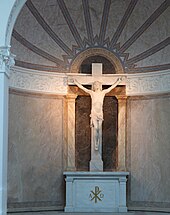Helenen Paulownen Mausoleum
The Helenen-Paulownen-Mausoleum is a listed mausoleum in the palace gardens of Schloss Ludwigslust . Erected for Helena Pawlowna Romanowa , it subsequently served as a burial place for eleven other relatives or spouses of the grand ducal house of Mecklenburg-Schwerin .
The building and its history
Helena Pavlovna Romanowa was the second daughter of Tsar Paul I of Russia (1754-1801) and his second wife, Tsarina Maria Feodorovna, Princess Sophie Dorothee of Württemberg (1759-1828). On October 23, 1799, the 14-year-old Grand Duchess Helena married the Hereditary Prince Friedrich Ludwig zu Mecklenburg (1778-1819), eldest son of Grand Duke Friedrich Franz I and his wife Princess Luise of Saxe-Gotha. She fell ill with pneumonia shortly after the birth of her daughter Marie Luise Friederike (1803–1862) and died on September 24, 1803 at the age of 18.
Hereditary Prince Friedrich Ludwig had a neoclassical mausoleum built for her, for which Joseph Christian Lillie and Joseph Ramée made plans. The Ramées design was implemented; in the opinion of the British architectural historian Paul V. Turner, however, taking over Lillie's planning elements. The construction in a quiet corner of the palace park with old oak and beech trees was carried out between 1804 and 1806 under the direction of the court gardener Schmidt and cost over 30,000 thalers . In addition to the old stock of trees, Friedrich Ludwig had new plantings of conifers , willows , poplars and flower sticks laid out.
The mausoleum is a brick building with lime plaster on the basis of an elongated square measuring 20 × 12 meters. The entrance is a porch ( peristyle ) supported by four pillars in a Doric - Tuscan order made of sandstone . On the architrave in gilt letters the dedicatory inscription is Helen PAULOWNEN attached. Nine steps lead to the mahogany door , decorated with bronze. A vestibule leads to the inner grave chapel, which was originally provided with a spherical vault made of stucco , which showed golden stars on a blue background. In the middle of the burial chapel two marble sarcophagi stood next to each other, one for Helene Paulowna, the other for the Hereditary Prince Friedrich Ludwig. At the four corners surrounding the sarcophagi dais four bronze standing candelabra . A blanket of crimson velvet embroidered with gold lay over the sarcophagus.
In the vestibule to the left of the wall, on a base of dark gray marble, there is a neoclassical relief image of the Grand Duchess and Hereditary Princess Helene Paulowna made of white marble, which was made and signed by the London sculptor Peter Rouw , who specializes in such memorial sculptures .
There was a Russian Orthodox chapel on the upper floor of the vestibule, from which a staircase leads . The iconostasis of the chapel painted Rudolph Suhrlandt with images of saints and the exaltation of the Princess Helena Pavlovna (1806). The chapel was used to hold memorial services in the Orthodox rite, for which the tsar sent embassy priests of the Russian embassy from Berlin to Ludwigslust twice a year. The painting came into the collection of the Grand Ducal Museum in 1882 .
The sickly and therefore mostly in Cannes Grand Duke Friedrich Franz III. had expressed the wish not to be buried in the much too restless cathedral in Schwerin, but in the mausoleum built not far from the Ludwigslust castle. Through the personal contacts of Friedrich Franz III. The Grand Duke's proposals for the Grand Ducal Secret Senior Building Officer Georg Daniel were bypassed the authorities and one of them was designated for implementation. This reconstruction began immediately after the death of Friedrich Franz III. by Daniel in April 1897, after the responsible Oberhofbaurat Hermann Willebrand was officially informed about it. The interior was given the character of a Greek hypäthral building supported by columns and closed with a glass roof , followed by a newly built apse . From November 1900 the apse was shaped by a large marble crucifix donated by Duke Johann Albrecht and executed by Wilhelm Wandschneider . Instead of the sarcophagi of Helena and Friedrich Ludwig, the sarcophagus of Friedrich Franz III. the central interior. After the renovation work was completed in June 1898, Daniel received the fixed fee of 1,500 marks.
The Ludwigsluster Mausoleum was used and cared for as a family burial place until the Second World War . Grand Duchess Anastasia, who outlived her husband by almost 25 years, was buried here in March 1922.
During the occupation after the Second World War, the mausoleum was broken into and the covers of the false sarcophagi were moved. Due to a shortage of materials, the building could only be locked in a burglar-proof manner. In 1970 it was expanded as a central depot for the then Museum of Prehistory and Early History in Schwerin. In 1977 a steel structure for shelves and as a false ceiling was put in for the various finds, but the interior architecture was not damaged. Then released in 2001 due to acute danger of collapse. Today under the care of the building and real estate company, Department State Palaces and Gardens in Mecklenburg-Western Pomerania, extensive renovation and restoration work has been carried out since 2003.
Funerals
In the Helenen-Paulownen-Mausoleum are buried in chronological order:
- Helena Paulowna
- Karoline Luise von Sachsen-Weimar-Eisenach (* 1786; † 1816), second wife of Hereditary Prince / Hereditary Grand Duke Friedrich Ludwig
- Magnus, Duke of Mecklenburg (* 1815; † 1816), son of Friedrich Ludwig
- Hereditary Grand Duke Friedrich Ludwig of Mecklenburg (* 1778; † 1819)
- Albrecht (Albert), Duke of Mecklenburg (* 1812; † 1834), son of Friedrich Ludwig
- Albrecht (Albert) von Sachsen-Altenburg (* 1827; † 1835), son of Marie zu Mecklenburg (1803-1862) and Georg (Sachsen-Altenburg)
- Auguste von Hessen-Homburg (* 1776; † 1871), third wife of Friedrich Ludwig
- Grand Duke Friedrich Franz III.
- Henry XVIII Reuss (* 1847, † 1911), husband of Charlotte, Duchess of Mecklenburg, daughter of Wilhelm of Mecklenburg
- Olga, Duchess of Mecklenburg (* 1916 - † 1917), daughter of Grand Duke Friedrich Franz IV.
- Grand Duchess Anastasia (* 1860 - † 1922), wife of Grand Duke Friedrich Franz III.
In the immediate vicinity of the mausoleum under an old oak is the grave of:
- Heinrich XXXVIII. Reuss († 1918, fallen), son of Heinrich XVIII. and Duchess Charlotte
literature
- Mausoleum, Helenen Paulownen, Grand Duchess of Russia, wed Hereditary Princess of Mecklenburg-Schwerin erected. In: Newspaper for the Elegant World 6 (1806), Sp. 265–267 ( digitized version )
- Friedrich Schlie : The art and history monuments of the Grand Duchy of Mecklenburg-Schwerin. III. Volume The district court districts of Hagenow, Wittenburg, Boizenburg, Lübenheen, Dömitz, Grabow, Ludwigslust, Neustadt, Crivitz, Brüel, Warin, Neubuckow, Kröpelin and Doberan. Schwerin 1899, p. 266f.
- Elsbeth Andre: Grand Duke Friedrich Franz III. and builder Georg Daniel. In: Mecklenburgische Jahrbücher. 119th year 2004 ISSN 0930-8229 pp. 263-277.
- Ilsabe von Bülow: Joseph Christian Lillie (1760-1827). Deutscher Kunstverlag, Berlin 2008, ISBN 9783422066106
Web links
- Literature on Helenen-Paulownen-Mausoleum in the state bibliography MV
- The Helenen-Paulownen-Mausoleum near the castles and gardens of Mecklenburg-Western Pomerania
Individual evidence
- ^ Ilsabe von Bülow (2007), p. 69 with reference to Paul Venable Turner: Joseph Ramée. International Architect of the Revolutionary Era. Cambridge / New York / Melbourne 1996 ISBN 978-0521495523 , pp. 148-152.
- ↑ a b c d e Friedrich Schlie: The art and history monuments of the Grand Duchy of Mecklenburg-Schwerin. III. Volume: the district court districts of Hagenow, Wittenburg, Boizenburg, Lübenheen, Dömitz, Grabow, Ludwigslust, Neustadt, Crivitz, Brüel, Warin, Neubuckow, Kröpelin and Doberan. Schwerin 1899, p. 266
- ^ A b c Newspaper for the Elegant World 6 (1806), Col. 265–267
- ↑ So the mausoleum was not previously a Russian Orthodox chapel, but also had an Orthodox chapel from the start.
- ^ Horst Ende: Georg Daniel as an architect and preservationist in Mecklenburg. Lecture on his 175th birthday on February 11, 2004 at the State Office for Monument Preservation in Schwerin.
- ↑ LHAS 2.26-2 Court Marshal's Office. No. 1316.
- ↑ LHAS 2.26-2 Court Marshal's Office. No. 1296.
- ↑ LHAS 2.12-1 / 10 funerals. No. 132 a, b.
- ^ The Helenen-Paulownen-Mausoleum , accessed on January 6, 2013
- ↑ Supplemented by Find a grave , accessed on January 6, 2013
Coordinates: 53 ° 19 ′ 25.4 ″ N , 11 ° 28 ′ 58.1 ″ E





